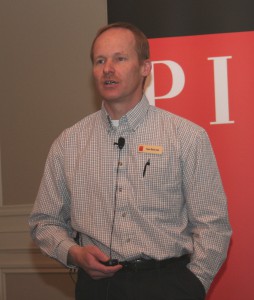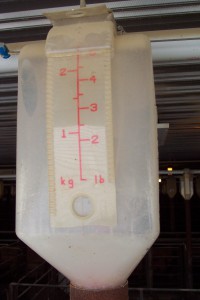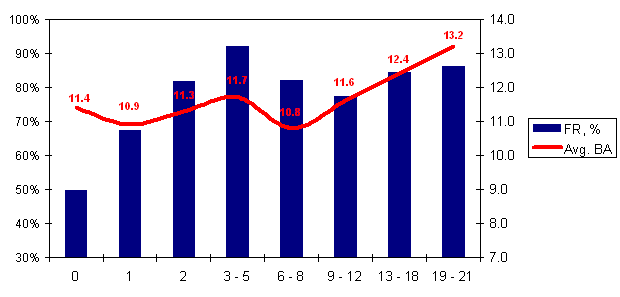 Targets for the breeding herd of 90% farrowing rate and 13.0 pigs born alive are realistic with good management, veterinarian Dr. Tom Riek told producers at a series of PIC Farm Manager Boot Camp meetings held across western Canada in April. If these figures are not being achieved, the reasons must be identified and action taken, he said. The difference between the top 10% of herds in the PIC League List, which have an average of 88.9% farrowing rate, and the top third, with 85.8%, is equivalent to an extra one pig weaned per sow each year. In order to reach the farrowing rate target, returns to service must be around 8%, with a further 2% of dropouts due to abortions, discharges, NIPs and deaths, Dr Riek suggested.
Targets for the breeding herd of 90% farrowing rate and 13.0 pigs born alive are realistic with good management, veterinarian Dr. Tom Riek told producers at a series of PIC Farm Manager Boot Camp meetings held across western Canada in April. If these figures are not being achieved, the reasons must be identified and action taken, he said. The difference between the top 10% of herds in the PIC League List, which have an average of 88.9% farrowing rate, and the top third, with 85.8%, is equivalent to an extra one pig weaned per sow each year. In order to reach the farrowing rate target, returns to service must be around 8%, with a further 2% of dropouts due to abortions, discharges, NIPs and deaths, Dr Riek suggested.
“Regular returns, which occur at 18-23, 40-44 or 60-64 days after breeding, are usually when something went wrong at service, for example timing or semen quality issues, or in the first two weeks of gestation, before implantation,” Dr. Riek explained. “Non-regular returns, which are usually 25-35 days after breeding, are related to the presence of less than five embryos beyond the implantation stage.” The ratio of regular to irregular returns should be around 3:1, he noted.
Feed levels important
Giving adequate amounts of feed is essential for good reproductive performance, Dr Riek stressed. “From a metabolic point of view, reproduction is a luxury. Breeding can only happen when the sow’s maintenance requirements are fully met.” In the three weeks prior to breeding, the gilt’s feed intake should be maximized, he said. “Also, during this time, any stress from movement, disease, lameness, vaccination or inadequate feed or water availability should be avoided.” Similarly, weaned sows should be fed as much as possible between weaning and breeding and then fed to recover any body condition loss sustained in lactation, Dr. Riek said. “Thin sows not fed to recover body tissues could lose embryos or even return.” He suggested a simple feeding program during gestation, based on the need to regain or control body condition. “Feeder boxes should be adjusted so that thin sows receive 6lbs per day in order to regain condition, to 5lbs in order to limit weight gain in normal sows and to 4lbs to control weight gain in fat sows,” he advised. Body condition should be evaluated and feeder adjustments made four days after breeding and at weeks 4, 10 and 14, he said.
During lactation, sows should consume an average of 13lbs (5.89kg) per day or 280lbs (127kg) during a 21-day suckling period, Dr. Riek suggested. “In order to maximize feed intake, feed should be mildly restricted pre-farrowing and for 2-3 days after farrowing and then full-fed,” he said.
Weaning to estrus interval has a major effect on both farrowing rate and litter size, with the maximum fertility occurring 3-5 days after weaning (see Fig. 1). From day 6 onwards, fertility drops and then recovers again after day 13. “In order to achieve the 90% farrowing rate target, it is essential to have as many sows as possible bred within the first 7 days after weaning,” Dr. Riek pointed out.
Figure 1: Reproductive performance according to WEI duration
From: Poleze et al., 2006
Service timing and semen quality are key factors
Timing of insemination is another key factor in achieving a high farrowing rate. “Sperm survives for up to 24 hours in the sow’s reproductive tract, but the eggs only live for 8-12 hours after ovulation,” explained Dr. Riek. “The best results are obtained when sows are inseminated 0-24 hours prior to ovulation. However, although we know that ovulation takes place in the last third to the last half of the heat period, we don’t know exactly when, so multiple mating is the answer.” Good timing will result in 90% or more multiple matings, he said. “Using a simple system, with heat detection once a day, in the morning, is the best approach for many units. Sows are bred one hour after heat detection and then every morning as long as they are in solid standing heat, regardless of parity.” However, gilts, returns and sows that have delayed estrus after weaning should be bred in the morning and the afternoon, ensuring that there is a minimum of 8 hours between matings, Dr. Riek advised.
Good semen storage practices are essential in order to ensure semen quality. “Semen must be stored in a narrow range of temperatures from 15-18oC (50-64oF),” Dr. Riek pointed out. “High temperatures are more detrimental to the viability of the doses than lower temperatures.” One third of refrigerators were found to be at an unacceptable temperature in a survey published in 2005, he noted. “Make sure the refrigerator is working well by using a Hi/Lo thermometer to evaluate the internal temperature,” he advised. “Also, do an annual check and service on the refrigerator before each summer.” In order to ensure an even temperature for semen, room should be left around the semen containers to allow air circulation. Ideally, semen should be used within 4 days of collection to ensure maximum motility, Dr. Riek advised. “Use semen as fresh as possible and keep in mind the policy of first in-first out.”
Culling of the less productive sows is necessary to boost overall herd performance, Dr Riek noted. “It’s hard, if not impossible, to improve when you do not cut the bottom 20%,” he stressed. Gilts that have not shown heat within 6 weeks of boar exposure and those with a low weight for age should be culled, he said. “Sows with no heat 4 weeks after weaning, sows that abort, sows with true vaginal discharges and second returns should also be removed.”
Photo captions:
- Tom Riek
- Drop box – Regular adjustment of sow feeders is required to maintain the correct body condition











